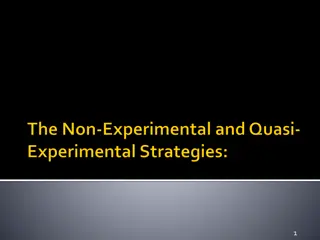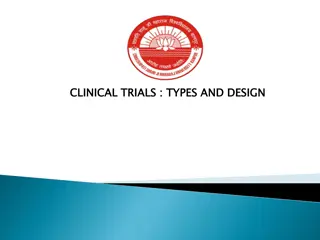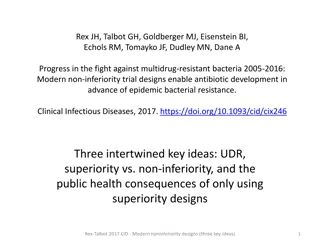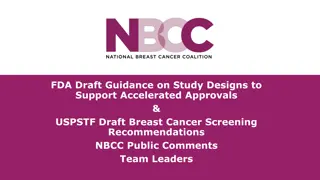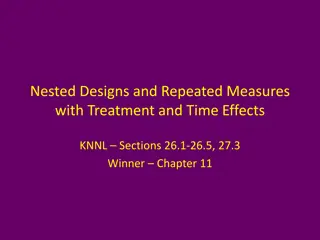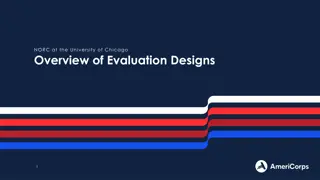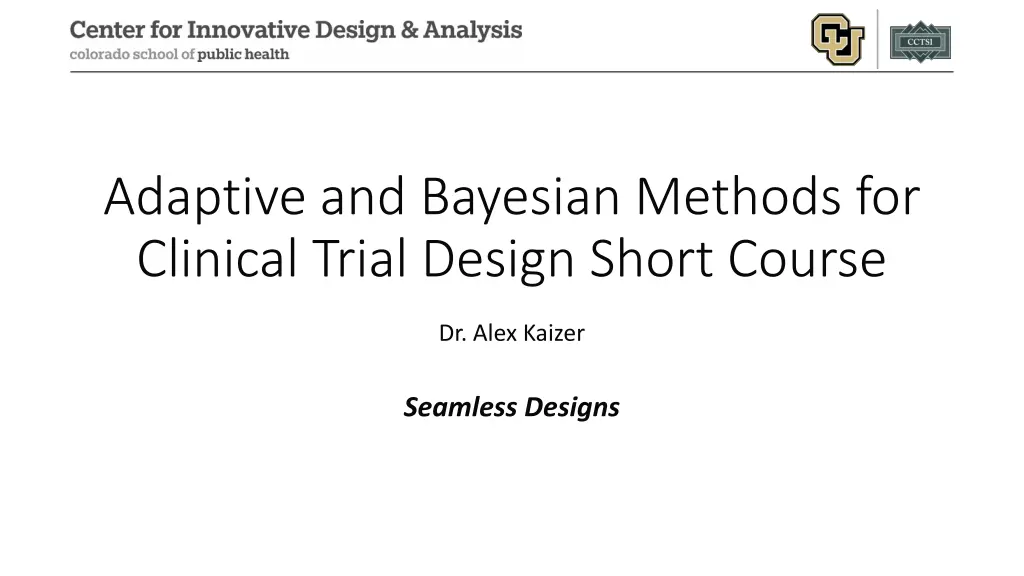
Adaptive and Bayesian Methods for Clinical Trial Design Course
"Learn about seamless trial designs, combining phases for efficient clinical trials. Understand the advantages, challenges, and connections to adaptive treatment selection. Join Dr. Alex Kaizer for insightful sessions. Enhance your knowledge in clinical trial methodology."
Uploaded on | 0 Views
Download Presentation

Please find below an Image/Link to download the presentation.
The content on the website is provided AS IS for your information and personal use only. It may not be sold, licensed, or shared on other websites without obtaining consent from the author. If you encounter any issues during the download, it is possible that the publisher has removed the file from their server.
You are allowed to download the files provided on this website for personal or commercial use, subject to the condition that they are used lawfully. All files are the property of their respective owners.
The content on the website is provided AS IS for your information and personal use only. It may not be sold, licensed, or shared on other websites without obtaining consent from the author.
E N D
Presentation Transcript
Adaptive and Bayesian Methods for Clinical Trial Design Short Course Dr. Alex Kaizer Seamless Designs
Background When going from one phase to another phase is as easy as consenting your next eligible trial participant 3
Motivation In traditional trials we conduct each phase or subphase a standalone trial, which likely extends the time until drawing a conclusion on intervention efficacy and has periods between studies to design the next trial In seamless designs, we attempt to seamlessly move from one phase or subphase to another (e.g., phase 2 to 3, 1b to 2a, 2a to 2b, etc.) Data may be used from across the entire study in our final analysis Related to the concept of adaptive treatment arm selection when multiple arms are considered in the earlier stage 4
Graphical Comparison of Traditional and Seamless Design 5
Seamless Designs Seamless study designs combine multiple phases of a study into one trial e.g., Phase II and Phase III combined to include both treatment selection and confirmation in one trial Interim analyses used to determine what continues from first phase portion of the study to the next phase Advantages include reducing overall study size, shorter development time, more long-term safety information Disadvantages include logistical challenges and issues maintaining statistical properties 6
Connection to Adaptive Treatment Arm Selection and Master Protocols There are numerous connections and similarities with seamless designs to treatment arm selection and master protocol designs like platform trials (see corresponding modules) Similarities include: Statistical considerations like type I error rate control Choice of decision rules (e.g., statistically significant versus using a threshold versus taking best arm(s) regardless of significance, etc.) Challenges with any temporal effects over the course of the trial 7
One Version of Seamless Phase II/III Designs Compare Treatment 1 and 2 after Phase II and drop least effective arm. Then compare efficacy after Phase III between the SOC and continued treatment using all data from Phases II and III. 8
Multi-Arm Multi-Stage MAMS can drop ineffective arms early on at an interim analysis. Promising arms seamlessly continue to a (confirmatory) Phase III trial. One disadvantage is that you can only compare Novel arms to the Control arm (to maintain the type I error and power). 9
Seamless Designs with Dose Finding Transitioning from dose finding to preliminary efficacy data (e.g., phase 1 to 2) may be an ideal context for a seamless design: If collecting efficacy data in phase 1, can incorporate in phase 2 to reduce needed sample size Can carry multiple doses forward and continue to refine (e.g., treatment arm selection) in phase 2 as evidence evolves May be more efficient than conducting a dose finding study and then having to design a separate, standalone trial 10
Surrogate Endpoints In seamless designs, we may use different outcomes for each phase. This may include a surrogate in phase 2 that we hope predicts the primary outcome in phase 3: A surrogate endpoint is expected to predict clinical benefit (or harm, or lack of benefit) based on epidemiologic, therapeutic, pathophysiologic, or other scientific evidence. (Biomarker Definitions Working Group) 11
Surrogate Mechanism of Action The surrogate should lie in the causal pathway Treatment has many mechanisms of action Treatment Other Mechanisms of Action Surrogate Marker Clinical Outcomes (Fleming and DeMets, Annals of Internal Medicine, 1996) 12
Best Situation for Surrogate Endpoints Intervention Surrogate Endpoint True Clinical Outcome Disease The surrogate lies on the only causal pathway of the disease process. 13
Reasons for Surrogate Endpoint Failure Surrogate not on the causal pathway of the disease process. Intervention only affects a pathway mediated through the surrogate. Surrogate isn t on pathway affected by intervention. Unintended or unknown mechanisms also affected by intervention. 14 Figure 1 (Fleming and DeMets)
FDA Endpoint Recommendation Examples Table 1 from Guidance for Industry. Clinical Trial Endpoints for the Approval of Cancer Drugs and Biologics. (December 2018) Table from FDA Facts: Biomarkers and Surrogate Endpoints webpage (December 2017) * TA-Traditional Approval, ** AA-Accelerated Approval, *** Not always recommended 15
Challenges with Surrogate Choice in Seamless Designs If we choose a poor or failed surrogate, this may affect the choice of the arm(s) that continue seamless to the next phase If the incorrect arm(s) are chosen, we may miss out on truly effective interventions and waste resources on a trial with less chance of finding a significant difference Well-chosen surrogates can help use more efficiently identify effective arms to move to the next phase and reduce sample size 16
Design Considerations If using a seamless design with a single study protocol, we must: Prespecify all decision rules and strategies for dropping/adding arms in the study protocol Predefine any interim analysis schedules Develop statistical analysis plans to span the needs of the multiple phases Identify data safety monitoring strategies and a DSMB with the needed expertise across trial phases 17
Case Study 18
Clinical Trial: Seamless Design Example Name: 26 Week Efficacy, Safety and Tolerability Study of Indacaterol in Patients With Chronic Obstructive Pulmonary Disease (COPD) (NCT00463567) Design: multi-center, randomized, double blind, double dummy, placebo-controlled, adaptive, seamless, parallel-group, with quadruple masking (participant, care provider, investigator, outcomes assessor) Population: age 40 and older, moderate-to-severe COPD, history of at least 20 pack years of smoking 19
Clinical Trial: Seamless Design Example Purpose: stage 1 was to select dose of indacaterol from 4 options (75, 150, 300, 600 g) and to evaluate study arms with placebo, formoterol, and tiotropium (which was an open-label arm due to delivery differences) N: 805 for stage 1 (selected based on simulations in S-plus) enrolled from April 2007 to September 2007 Randomization Ratio: 1:1:1:1:1:1:1 20
Clinical Trial: Seamless Design Example Primary Outcome: Stage 1: trough forced expiratory volume in 1 second (FEV1) assessed by spirometry 24 hours post dose after 15 days of treatment Stage 2: trough forced expiratory volume in 1 second (FEV1) assessed by spirometry 24 hours post dose after 12 weeks of treatment Seamless Consideration: at least 110 per group (770 total) with at least 2 weeks of treatment, then brief pause with interim analysis to determine dose(s) to keep or drop for 26-week follow-up in stage 2 21
Clinical Trial: Seamless Design Example Arms Kept After Interim Analysis to Move to Phase 2 of Trial Indacaterol 150 g Indacaterol 300 g Tiotropium 18 g Placebo Arms Dropped After Interim Analysis Indacaterol 75 g Indacaterol 600 g DSMB noted no safety concerns at any dose Formoterol 12 g 23
Clinical Trial: Seamless Design Example Stage 2 ultimately enrolled 1683 across the four included study arms (this includes Stage 1 participants in addition to participants enrolled in Stage 1) Those in dropped arms were not re-randomized, but did have study follow- up and close-out debriefed Noted no major differences in adverse events across study arms All 3 active therapy arms improved FEV1 significantly relative to placebo (p<0.001 for each pairwise comparison) In conclusion, once-daily indacaterol provides clinically and statistically significant bronchodilation compared with placebo at 24 hours post dose after 12 weeks of treatment, demonstrating its suitability for once-daily dosing. Relative to tiotropium, the effect on trough FEV1 met prespecified requirements for statistical noninferiority. (Donohue 2010) 24
Module Conclusions Seamless designs allow for more efficient use of data across multiple studies and reduces the time between studies by incorporating them under one protocol Designs may allow for longer term follow-up, especially of stage 1 participants, and allow for delayed or rarer adverse events One must carefully consider the outcomes for each stage of a seamless design, especially if surrogate outcomes are used Ideal to combine dose finding with initial efficacy, more generally useful for nonpivotal studies 25
References Kaizer, Alexander M., et al. "Recent innovations in adaptive trial designs: a review of design opportunities in translational research." Journal of Clinical and Translational Science (2023): 1-35. US Food and Drug Administration. Adaptive designs for clinical trials of drugs and biologics guidance for industry. https://www.fda.gov/regulatory-information/search-fda-guidance-documents/adaptive-design- clinical-trials-drugs-and-biologics-guidance-industry Li, Qing, Jianchang Lin, and Yunzhi Lin. "Adaptive design implementation in confirmatory trials: methods, practical considerations and case studies." Contemporary Clinical Trials 98 (2020): 106096. Barnes, Peter J., et al. "Integrating indacaterol dose selection in a clinical study in COPD using an adaptive seamless design." Pulmonary pharmacology & therapeutics 23.3 (2010): 165-171. Donohue, James F et al. Once-daily bronchodilators for chronic obstructive pulmonary disease: indacaterol versus tiotropium. American journal of respiratory and critical care medicine vol. 182,2 (2010): 155-62. doi:10.1164/rccm.200910-1500OC
Contact Info: Email: alex.kaizer@cuanschutz.edu Website: www.alexkaizer.com GitHub: alexbiostats






